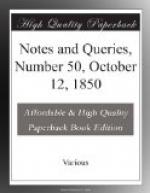2. What was its size and make? One account describes it as made of gold, and another (Rites of Durham, p. 16.) as of silver.
3. Was the “Black Rood of Scotland” the same as the “Holy Cross of Holyrood House?” One account seems to make them the same: for in the Rites of Durham, p. 16., we read,—
“At the east end of the south aisle of the choir, was a most fair rood, or picture of our Saviour, in silver, called the Black Rood of Scotland, brought out of Holyrood House by King David Bruce, and was won at the battle of Durham, with the picture of our Lady on the one side, and St. John on the other side, very richly wrought in silver, all three having crowns of gold,” &c. &c.
Another account, in p. 21 of the same work, seems to make them different; for, speaking of the battle of Neville’s Cross (18th October, 1346), it says—
“In which said battle
a holy Cross, which was taken out of
Holyrood House, in Scotland,
by King David Bruce, was won and
taken,” &c., p. 21.
And adds,—
“In which battle were slain seven earls of Scotland.... and also lost the said cross, and many other most worthy and excellent jewels ... together with the Black Rood of Scotland (so termed) with Mary and John, made of silver, being, as it were, smoked all over,” &c., p. 22.
4. If they were the same, how is the legend concerning its discovery by the king, upon Holyrood day, when hunting in a forest near Edinburgh, to be reconciled with the fact of its being taken by St. Margaret into Scotland? If they were not the same, what was the previous history of each, and which was the cross of St. Margaret?
5. How is the account of Simeon of Durham, that the Black Rood was bequeathed to Durham Priory by St. Margaret, to be reconciled with the history of its being taken from the Scotch at the battle of Neville’s Cross?
6. May there not be a connexion between the legend of the discovery of the “Holy Cross” between the horns of a wild hart (Rites of Durham, p. 21.), and the practice that existed of an offering of a stag annually made, on St. Cuthbert’s day, in September, by the Nevilles of Raby, to the Priory of Durham? May it not have been an acknowledgement {309} that the cross won at the battle of Neville’s Cross was believed to have been taken by King David from the hart in the forest of Edinburgh? In the “Lament for Robert Neville,” called by Surtees “the very oldest rhyme of the North” we read—
“Wel, qwa sal thir hornes blaw
Haly rod thi day?
Nou is he dede and lies law
Was wont to blaw thaim
ay.”
7. Is it known what became of the “Holy Cross” or “Black Rood” at the dissolution of Durham Priory?
P.A.F.
Newcastle-on-Tyne.
* * * * *
MINOR QUERIES.




